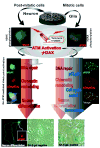DNA damage responses in neural cells: Focus on the telomere
- PMID: 17207936
- PMCID: PMC1924472
- DOI: 10.1016/j.neuroscience.2006.11.052
DNA damage responses in neural cells: Focus on the telomere
Abstract
Postmitotic neurons must survive for the entire life of the organism and be able to respond adaptively to adverse conditions of oxidative and genotoxic stress. Unrepaired DNA damage can trigger apoptosis of neurons which is typically mediated by the ataxia telangiectasia mutated (ATM)-p53 pathway. As in all mammalian cells, telomeres in neurons consist of TTAGGG DNA repeats and several associated proteins that form a nucleoprotein complex that prevents chromosome ends from being recognized as double strand breaks. Proteins that stabilize telomeres include TRF1 and TRF2, and proteins known to play important roles in DNA damage responses and DNA repair including ATM, Werner and the catalytic subunit of DNA-dependent protein kinase (DNA-PKcs). We have been performing studies of developing and adult neurons aimed at understanding the effects of global and telomere-directed DNA damage responses in neuronal plasticity and survival in the contexts of aging and neurodegenerative disorders. Deficits in specific DNA repair proteins, including DNA-PKcs and uracil DNA glycosylase (UDG), render neurons vulnerable to adverse conditions of relevance to the pathogenesis of neurodegenerative disorders such as Alzheimer's disease and stroke. Similarly, early postmitotic neurons with reduced telomerase activity exhibit accentuated responses to DNA damage and are prone to apoptosis demonstrating a pivotal role for telomere maintenance in both mitotic cells and postmitotic neurons. Our recent findings suggest key roles for TRF2 in regulating the differentiation and survival of neurons. TRF2 affects cell survival and differentiation by modulating DNA damage pathways, and gene expression. A better understanding of the molecular mechanisms by which neurons respond to global and telomere-specific DNA damage may reveal novel strategies for prevention and treatment of neurodegenerative disorders. Indeed, work in this and other laboratories has shown that dietary folic acid can protect neurons against Alzheimer's disease by keeping homocysteine levels low and thereby minimizing the misincorporation of uracil into DNA in neurons.
Figures


Similar articles
-
TRF2 dysfunction elicits DNA damage responses associated with senescence in proliferating neural cells and differentiation of neurons.J Neurochem. 2006 Apr;97(2):567-81. doi: 10.1111/j.1471-4159.2006.03779.x. Epub 2006 Mar 15. J Neurochem. 2006. PMID: 16539655
-
DNA processing is not required for ATM-mediated telomere damage response after TRF2 deletion.Nat Cell Biol. 2005 Jul;7(7):712-8. doi: 10.1038/ncb1275. Epub 2005 Jun 19. Nat Cell Biol. 2005. PMID: 15968270
-
DNA damage-induced phosphorylation of the human telomere-associated protein TRF2.Proc Natl Acad Sci U S A. 2005 Oct 25;102(43):15539-44. doi: 10.1073/pnas.0507915102. Epub 2005 Oct 13. Proc Natl Acad Sci U S A. 2005. PMID: 16223874 Free PMC article.
-
DNA repair factors and telomere-chromosome integrity in mammalian cells.Cytogenet Genome Res. 2004;104(1-4):116-22. doi: 10.1159/000077475. Cytogenet Genome Res. 2004. PMID: 15162024 Review.
-
[ATM and telomere instability].Yi Chuan Xue Bao. 2004 Feb;31(2):212-6. Yi Chuan Xue Bao. 2004. PMID: 15473314 Review. Chinese.
Cited by
-
Mutant huntingtin impairs Ku70-mediated DNA repair.J Cell Biol. 2010 May 3;189(3):425-43. doi: 10.1083/jcb.200905138. J Cell Biol. 2010. PMID: 20439996 Free PMC article.
-
Identification of neural outgrowth genes using genome-wide RNAi.PLoS Genet. 2008 Jul 4;4(7):e1000111. doi: 10.1371/journal.pgen.1000111. PLoS Genet. 2008. PMID: 18604272 Free PMC article.
-
Randomized control trial evaluation of a modified Paleolithic dietary intervention in the treatment of relapsing-remitting multiple sclerosis: a pilot study.Degener Neurol Neuromuscul Dis. 2017 Jan 4;7:1-18. doi: 10.2147/DNND.S116949. eCollection 2017. Degener Neurol Neuromuscul Dis. 2017. PMID: 30050374 Free PMC article.
-
Does ionizing radiation influence Alzheimer's disease risk?J Radiat Res. 2012 Nov 1;53(6):815-22. doi: 10.1093/jrr/rrs036. Epub 2012 Aug 7. J Radiat Res. 2012. PMID: 22872779 Free PMC article. Review.
-
Meta-analysis of Telomere Length in Alzheimer's Disease.J Gerontol A Biol Sci Med Sci. 2016 Aug;71(8):1069-73. doi: 10.1093/gerona/glw053. Epub 2016 Apr 18. J Gerontol A Biol Sci Med Sci. 2016. PMID: 27091133 Free PMC article.
References
-
- Ai W, Bertram PG, Tsang CK, Chan TF, Zheng XF. Regulation of subtelomeric silencing during stress response. Mol Cell. 2002;10:1295–305. - PubMed
-
- Antoine K, Ferbus D, Kolahgar G, Prosperi MT, Goubin G. Zinc finger protein overexpressed in colon carcinoma interacts with the telomeric protein hRap1. J Cell Biochem. 2005;95:763–768. - PubMed
-
- Baek S, Bu Y, Kim H, Kim H. Telomerase induction in astrocytes of Sprague-Dawley rat after ischemic brain injury. Neurosci Lett. 2004;363:94–6. - PubMed
-
- Baker E, Hinton L, Callen DF, Altree M, Dobbie A, Eyre HJ, Sutherland GR, Thompson E, Thompson P, Woollatt E, Haan E. Study of 250 children with idiopathic mental retardation reveals nine cryptic and diverse subtelomeric chromosome anomalies. Am J Med Genet. 2002;107:285–93. - PubMed
-
- Bakkenist CJ, Kastan MB. DNA damage activates ATM through intermolecular autophosphorylation and dimer dissociation. Nature. 2003;421:499–506. - PubMed
Publication types
MeSH terms
Substances
Grants and funding
LinkOut - more resources
Full Text Sources
Medical
Research Materials
Miscellaneous

